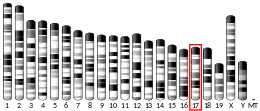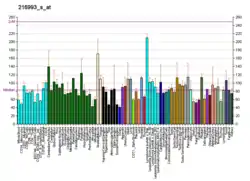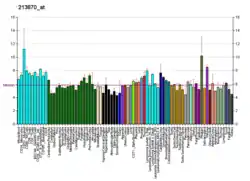| COL11A2 | |||||||||||||||||||||||||||||||||||||||||||||||||||
|---|---|---|---|---|---|---|---|---|---|---|---|---|---|---|---|---|---|---|---|---|---|---|---|---|---|---|---|---|---|---|---|---|---|---|---|---|---|---|---|---|---|---|---|---|---|---|---|---|---|---|---|
| Identifiers | |||||||||||||||||||||||||||||||||||||||||||||||||||
| Aliases | COL11A2, DFNA13, DFNB53, FBCG2, HKE5, PARP, STL3, collagen type XI alpha 2, collagen type XI alpha 2 chain, OSMEDB, OSMEDA | ||||||||||||||||||||||||||||||||||||||||||||||||||
| External IDs | OMIM: 120290 MGI: 88447 HomoloGene: 22547 GeneCards: COL11A2 | ||||||||||||||||||||||||||||||||||||||||||||||||||
| |||||||||||||||||||||||||||||||||||||||||||||||||||
| |||||||||||||||||||||||||||||||||||||||||||||||||||
| |||||||||||||||||||||||||||||||||||||||||||||||||||
| |||||||||||||||||||||||||||||||||||||||||||||||||||
| |||||||||||||||||||||||||||||||||||||||||||||||||||
| Wikidata | |||||||||||||||||||||||||||||||||||||||||||||||||||
| |||||||||||||||||||||||||||||||||||||||||||||||||||
Collagen alpha-2(XI) chain is a protein that in humans is encoded by the COL11A2 gene.[5][6][7]
The COL11A2 gene produces one component of this type of collagen, called the pro-alpha2(XI) chain. Type XI collagen adds structure and strength to the tissues that support the body's muscles, joints, organs and skin (the connective tissue). Type XI collagen is normally found in cartilage as well as the fluid that fills the eyeball, the inner ear, and the center portion of the discs between the vertebrae in the spine (nucleus pulposus). Type XI collagen also helps maintain the spacing and diameter of type II collagen fibrils. Type II collagen is an important component of the eye and mature cartilage tissue. The size and arrangement of type II collagen fibrils is essential for the normal structure of these tissues.
The pro-alpha2(XI) chain combines with pro-alpha1(XI) and pro-alpha1(II)collagen chains to form a procollagen molecule. These triple-stranded, ropelike procollagen molecules must be processed by enzymes in the cell. Once processed, these procollagen molecules leave the cell and arrange themselves into long, thin fibrils that cross-link to one another in the spaces around cells. The cross-linkages result in the formation of very strong mature type XI collagen fibers.
The COL11A2 gene is located on the short (p) arm of chromosome 6 at position 21.3, from base pair 33,238,446 to base pair 33,268,222.
Function
This gene encodes one of the two alpha chains of type XI collagen, a minor fibrillar collagen. It is located on chromosome 6 very close to but separate from the gene for retinoid X receptor beta. Type XI collagen is a heterotrimer but the third alpha chain is a post-translationally modified alpha 1 type II chain. Proteolytic processing of this type XI chain produces PARP, a proline/arginine-rich protein that is an amino terminal domain. Mutations in this gene are associated with type III Stickler syndrome, otospondylomegaepiphyseal dysplasia (OSMED syndrome), Weissenbacher-Zweymuller syndrome, and autosomal dominant nonsyndromic sensorineural 13 deafness. Three transcript variants encoding different isoforms have been identified for this gene.[7]
Clinical significance
Nonsyndromic deafness
Mutations in the COL11A2 gene have been shown to cause hearing loss without other signs or symptoms (nonsyndromic deafness autosomal dominant) in two large families. One family carries a mutation that substitutes the amino acid cysteine (a building block of proteins) for the amino acid arginine at position 549 (written as Arg549Cys) in the alpha 2 chain of type XI collagen. A second family has a mutation that substitutes the amino acid glutamic acid for the amino acid glycine at position 323 (written as Gly323Glu) in this protein. These mutations prevent the normal assembly of type XI collagen. Type XI collagen plays an important role in the structure and function of the inner ear. When mutations in the COL11A2 gene affect the structure of collagen fibrils, hearing loss can result.
Otospondylomegaepiphyseal dysplasia
Approximately 10 mutations identified in the COL11A2 gene are responsible for otospondylomegaepiphyseal dysplasia (OSMED). Most of these mutations result in a complete lack of pro-alpha2(XI) chains, which leads to a loss of function of type XI collagen. Some mutations affect the production of the pro-alpha2(XI) chain and disrupt normal collagen assembly. Because this type of collagen is an important component of cartilage and other connective tissues, these mutations result in the characteristic signs and symptoms of OSMED.
Stickler syndrome
Stickler syndrome (COL11A2): Stickler syndrome is a disorder that causes problems with skeletal development, vision, and hearing. Mutations in the COL11A2 gene cause a form of Stickler in which vision is not affected. COL11A2 mutations cause abnormal production of the pro-alpha2(XI) chain, part of type XI collagen. As a result, type XI collagen is impaired and cannot function properly, causing the skeletal and hearing problems characteristic of Stickler syndrome. The pro-alpha2(XI) chain, however, is not made in the eyes. Instead, another type of collagen chain replaces pro-alpha2(XI) to form type XI collagen in the vitreous of the eye. COL11A2 mutations, therefore, do not affect vision.
Weissenbacher-Zweymüller syndrome
At least one identified mutation in the COL11A2 gene is responsible for Weissenbacher-Zweymüller syndrome. This mutation causes the amino acid glycine to be replaced with the amino acid glutamic acid at position 955 in the alpha 2 chain of type XI collagen (written as Gly955Glu). This mutation prevents collagen molecules from being assembled properly, which disrupts the structure of type XI collagen. These changes result in the characteristic signs and symptoms of Weissenbacher-Zweymüller syndrome.
Vasculitis
A link has been shown between ANCA-associated vasculitis and SNPs in the COL11A2 gene in a Genomewide Association Study. It is proposed that this association may be due to linkage disequilibrium between a SNP in the HLA-DP locus and SNPs in COL11A2. This is theorised as the SNP in the HLA molecule was found to be very strongly associated with these diseases with evidence for a single genetic association.
References
- 1 2 3 ENSG00000232541, ENSG00000227801, ENSG00000230930, ENSG00000206290, ENSG00000235708, ENSG00000223699 GRCh38: Ensembl release 89: ENSG00000204248, ENSG00000232541, ENSG00000227801, ENSG00000230930, ENSG00000206290, ENSG00000235708, ENSG00000223699 - Ensembl, May 2017
- 1 2 3 GRCm38: Ensembl release 89: ENSMUSG00000024330 - Ensembl, May 2017
- ↑ "Human PubMed Reference:". National Center for Biotechnology Information, U.S. National Library of Medicine.
- ↑ "Mouse PubMed Reference:". National Center for Biotechnology Information, U.S. National Library of Medicine.
- ↑ Vuristo MM, Pihlajamaa T, Vandenberg P, Prockop DJ, Ala-Kokko L (September 1995). "The human COL11A2 gene structure indicates that the gene has not evolved with the genes for the major fibrillar collagens". The Journal of Biological Chemistry. 270 (39): 22873–81. doi:10.1074/jbc.270.39.22873. PMID 7559422.
- ↑ McGuirt WT, Prasad SD, Griffith AJ, Kunst HP, Green GE, Shpargel KB, Runge C, Huybrechts C, Mueller RF, Lynch E, King MC, Brunner HG, Cremers CW, Takanosu M, Li SW, Arita M, Mayne R, Prockop DJ, Van Camp G, Smith RJ (December 1999). "Mutations in COL11A2 cause non-syndromic hearing loss (DFNA13)". Nature Genetics. 23 (4): 413–9. doi:10.1038/70516. PMID 10581026. S2CID 24289573.
- 1 2 "Entrez Gene: COL11A2 collagen, type XI, alpha 2".
Further reading
- Kuivaniemi H, Tromp G, Prockop DJ (1997). "Mutations in fibrillar collagens (types I, II, III, and XI), fibril-associated collagen (type IX), and network-forming collagen (type X) cause a spectrum of diseases of bone, cartilage, and blood vessels". Human Mutation. 9 (4): 300–15. doi:10.1002/(SICI)1098-1004(1997)9:4<300::AID-HUMU2>3.0.CO;2-9. PMID 9101290. S2CID 6890740.
- Van Camp G, Willems PJ, Smith RJ (April 1997). "Nonsyndromic hearing impairment: unparalleled heterogeneity". American Journal of Human Genetics. 60 (4): 758–64. PMC 1712474. PMID 9106521.
- Hanson IM, Gorman P, Lui VC, Cheah KS, Solomon E, Trowsdale J (November 1989). "The human alpha 2(XI) collagen gene (COL11A2) maps to the centromeric border of the major histocompatibility complex on chromosome 6". Genomics. 5 (4): 925–31. doi:10.1016/0888-7543(89)90135-3. PMID 2591970.
- Kimura T, Cheah KS, Chan SD, Lui VC, Mattei MG, van der Rest M, Ono K, Solomon E, Ninomiya Y, Olsen BR (August 1989). "The human alpha 2(XI) collagen (COL11A2) chain. Molecular cloning of cDNA and genomic DNA reveals characteristics of a fibrillar collagen with differences in genomic organization". The Journal of Biological Chemistry. 264 (23): 13910–6. doi:10.1016/S0021-9258(18)80086-2. PMID 2760050.
- Keene DR, Oxford JT, Morris NP (October 1995). "Ultrastructural localization of collagen types II, IX, and XI in the growth plate of human rib and fetal bovine epiphyseal cartilage: type XI collagen is restricted to thin fibrils". The Journal of Histochemistry and Cytochemistry. 43 (10): 967–79. doi:10.1177/43.10.7560887. PMID 7560887.
- Zhidkova NI, Justice SK, Mayne R (April 1995). "Alternative mRNA processing occurs in the variable region of the pro-alpha 1(XI) and pro-alpha 2(XI) collagen chains". The Journal of Biological Chemistry. 270 (16): 9486–93. doi:10.1074/jbc.270.16.9486. PMID 7721876.
- Tsumaki N, Kimura T (February 1995). "Differential expression of an acidic domain in the amino-terminal propeptide of mouse pro-alpha 2(XI) collagen by complex alternative splicing". The Journal of Biological Chemistry. 270 (5): 2372–8. doi:10.1074/jbc.270.5.2372. PMID 7836472.
- Vikkula M, Mariman EC, Lui VC, Zhidkova NI, Tiller GE, Goldring MB, van Beersum SE, de Waal Malefijt MC, van den Hoogen FH, Ropers HH (February 1995). "Autosomal dominant and recessive osteochondrodysplasias associated with the COL11A2 locus". Cell. 80 (3): 431–7. doi:10.1016/0092-8674(95)90493-X. hdl:2066/21466. PMID 7859284. S2CID 5681665.
- Zhidkova NI, Brewton RG, Mayne R (July 1993). "Molecular cloning of PARP (proline/arginine-rich protein) from human cartilage and subsequent demonstration that PARP is a fragment of the NH2-terminal domain of the collagen alpha 2(XI) chain". FEBS Letters. 326 (1–3): 25–8. doi:10.1016/0014-5793(93)81753-M. PMID 8325374. S2CID 40459191.
- Lui VC, Ng LJ, Sat EW, Nicholls J, Cheah KS (July 1996). "Extensive alternative splicing within the amino-propeptide coding domain of alpha2(XI) procollagen mRNAs. Expression of transcripts encoding truncated pro-alpha chains" (PDF). The Journal of Biological Chemistry. 271 (28): 16945–51. doi:10.1074/jbc.271.28.16945. PMID 8663204. S2CID 54963003.
- Lui VC, Ng LJ, Sat EW, Cheah KS (March 1996). "The human alpha 2(XI) collagen gene (COL11A2): completion of coding information, identification of the promoter sequence, and precise localization within the major histocompatibility complex reveal overlap with the KE5 gene". Genomics. 32 (3): 401–12. doi:10.1006/geno.1996.0135. PMID 8838804.
- van Steensel MA, Buma P, de Waal Malefijt MC, van den Hoogen FH, Brunner HG (June 1997). "Oto- spondylo-megaepiphyseal dysplasia (OSMED): clinical description of three patients homozygous for a missense mutation in the COL11A2 gene" (PDF). American Journal of Medical Genetics. 70 (3): 315–23. doi:10.1002/(SICI)1096-8628(19970613)70:3<315::AID-AJMG19>3.0.CO;2-O. hdl:2066/24596. PMID 9188673. S2CID 20127516.
- Sirko-Osadsa DA, Murray MA, Scott JA, Lavery MA, Warman ML, Robin NH (February 1998). "Stickler syndrome without eye involvement is caused by mutations in COL11A2, the gene encoding the alpha2(XI) chain of type XI collagen". The Journal of Pediatrics. 132 (2): 368–71. doi:10.1016/S0022-3476(98)70466-4. PMID 9506662.
- Koga H, Sakou T, Taketomi E, Hayashi K, Numasawa T, Harata S, Yone K, Matsunaga S, Otterud B, Inoue I, Leppert M (June 1998). "Genetic mapping of ossification of the posterior longitudinal ligament of the spine". American Journal of Human Genetics. 62 (6): 1460–7. doi:10.1086/301868. PMC 1377147. PMID 9585596.
- Pihlajamaa T, Prockop DJ, Faber J, Winterpacht A, Zabel B, Giedion A, Wiesbauer P, Spranger J, Ala-Kokko L (November 1998). "Heterozygous glycine substitution in the COL11A2 gene in the original patient with the Weissenbacher-Zweymüller syndrome demonstrates its identity with heterozygous OSMED (nonocular Stickler syndrome)". American Journal of Medical Genetics. 80 (2): 115–20. doi:10.1002/(SICI)1096-8628(19981102)80:2<115::AID-AJMG5>3.0.CO;2-O. PMID 9805126.
- Melkoniemi M, Brunner HG, Manouvrier S, Hennekam R, Superti-Furga A, Kääriäinen H, Pauli RM, van Essen T, Warman ML, Bonaventure J, Miny P, Ala-Kokko L (February 2000). "Autosomal recessive disorder otospondylomegaepiphyseal dysplasia is associated with loss-of-function mutations in the COL11A2 gene". American Journal of Human Genetics. 66 (2): 368–77. doi:10.1086/302750. PMC 1288089. PMID 10677296.





